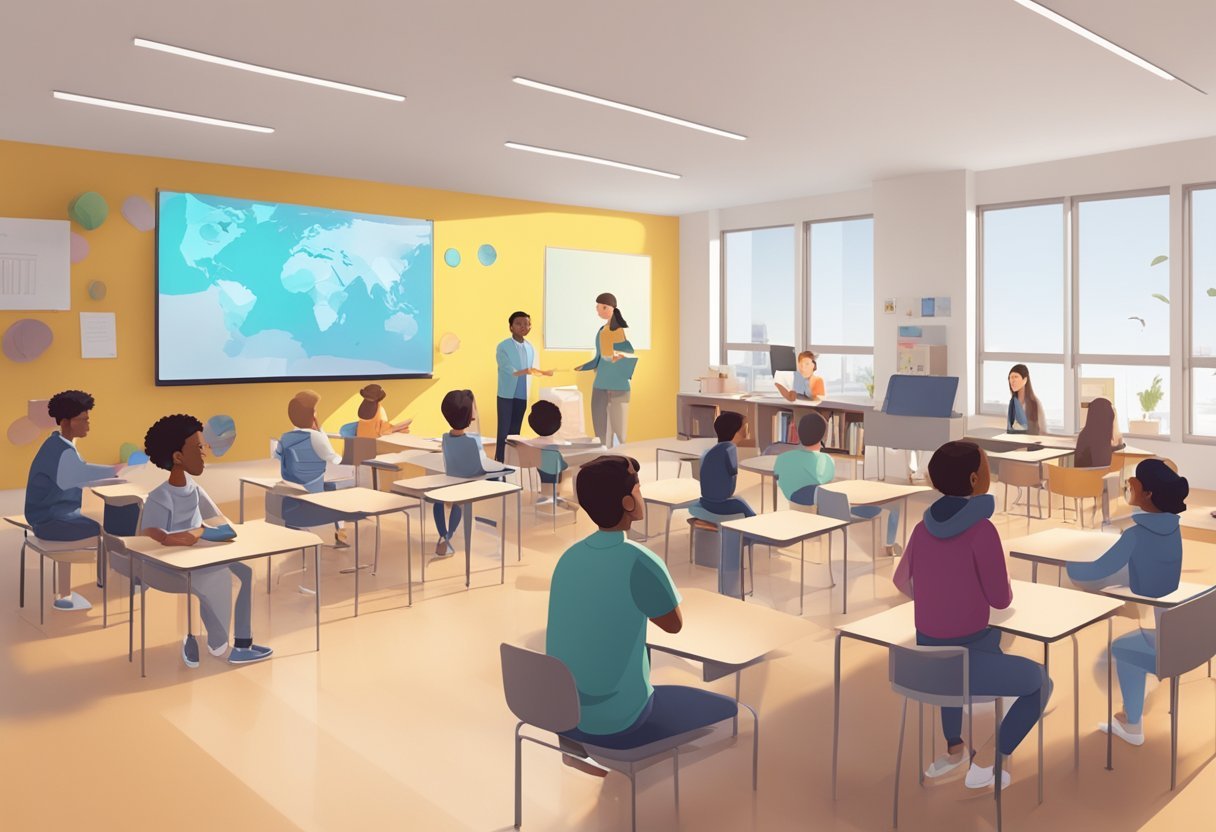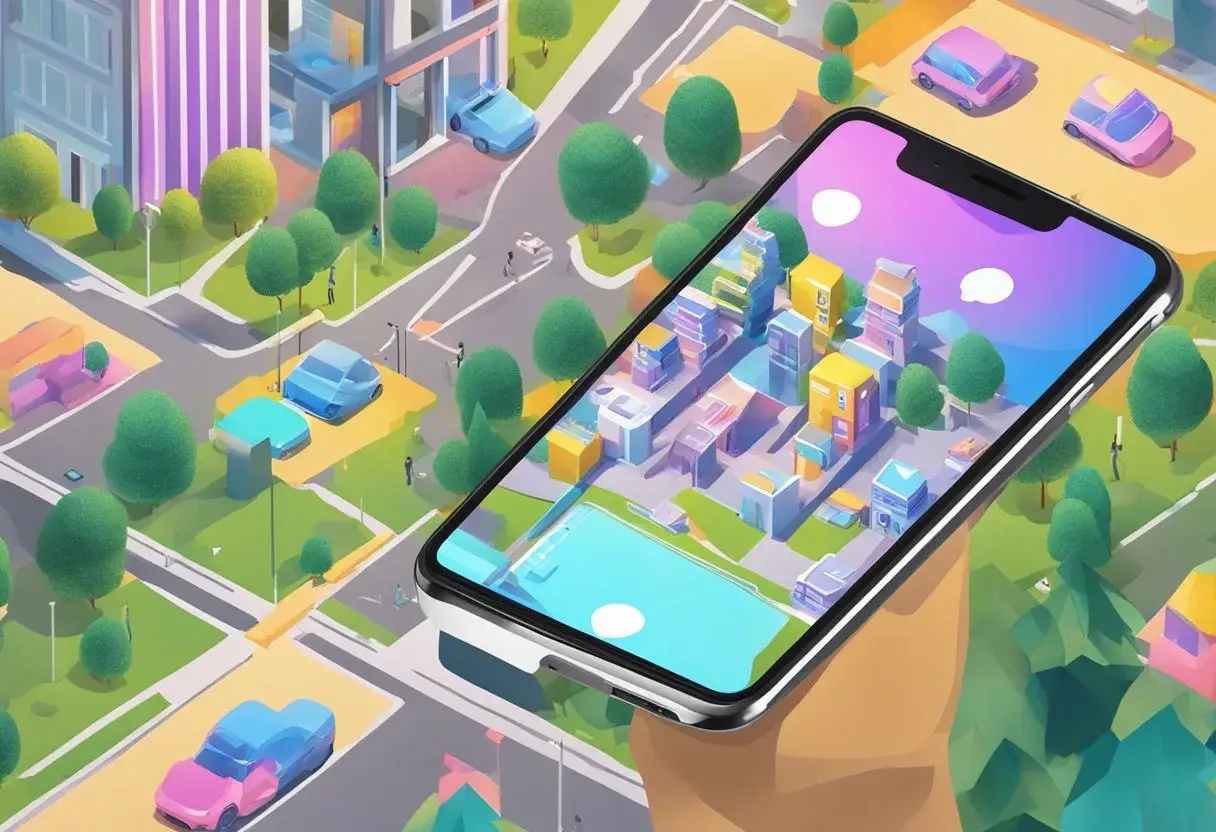Augmented reality (AR) is transforming the way students learn and engage with the world around them. AR technology uses digital overlays to enhance the real world, creating an interactive and immersive learning experience. By integrating AR into the classroom, students can explore complex concepts in a visual and interactive way, making learning more engaging and effective. In this blog post, I will discuss augmented reality in schools and share with you how it works and 10 AR tools you can use in schools
The role of AR in education is becoming increasingly important as technology continues to advance. AR can be used across disciplines, from science and math to history and language arts. By incorporating AR into curriculum design, educators can create a more dynamic and interactive learning experience for students. AR tools such as Merge Cube, CoSpaces Edu, and Augmented Classroom are just a few examples of the many technological tools available to educators to enhance student engagement and learning.
The Role of Augmented Reality in Schools
Augmented Reality (AR) is a technology that overlays digital information onto the real-world environment. AR has been gaining traction in recent years, and its potential in education is enormous. AR can help to enhance interactive learning, improve understanding of complex concepts, and create a more engaging and immersive learning experience for students.
Enhancing Interactive Learning
AR can enhance interactive learning by providing students with a more hands-on and engaging experience. With AR, students can interact with digital objects in the real world, allowing them to explore and learn in a more immersive way. For example, students can use AR to explore the human body, interact with historical artifacts, or explore complex scientific concepts.
Improving Understanding of Complex Concepts
AR can also help to improve understanding of complex concepts. By overlaying digital information onto the real world, AR can help students visualize and understand abstract concepts in a more concrete way. For example, students can use AR to explore the molecular structure of a chemical compound, or to visualize complex mathematical equations.
Augmented Reality vs. Virtual Reality in Classrooms
While both AR and Virtual Reality (VR) have the potential to revolutionize education, they have different strengths and weaknesses. VR provides a fully immersive experience, allowing students to explore and interact with virtual environments in a more realistic way.
However, VR requires expensive equipment and can be isolating for students. AR, on the other hand, provides a more interactive and collaborative experience, allowing students to interact with digital objects in the real world. AR is also more accessible than VR, as it can be used with a smartphone or tablet.
AR has the potential to transform education by providing students with a more engaging and immersive learning experience. By enhancing interactive learning, improving understanding of complex concepts, and providing a more engaging and collaborative learning experience, AR can help to prepare students for the challenges of the 21st century.
10 Augmented Reality Tools for schools
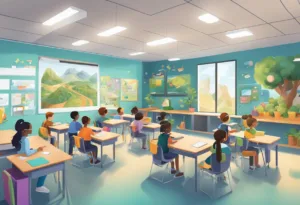
- Merge Cube
- Google Expeditions
- Quiver
- Aurasma (HP Reveal)
- Blippar
- Anatomy 4D
- Elements 4D
- CoSpaces Edu
- AR Flashcards
- ZooBurst
Merge Cube
Merge Cube is an innovative educational tool that transforms the way students interact with technology. It’s a physical cube that can be held and manipulated, and when combined with a smartphone or tablet, it brings digital content to life in the palm of the student’s hand.
The cube works with various apps that allow students to explore a multitude of subjects, such as science, math, social studies, and the arts, in an immersive and interactive way. For example, students can hold and examine virtual objects from all angles, dissect a frog, or even delve into the Earth’s core, providing a tactile learning experience that enhances understanding and retention.
Google Expeditions
Google Expeditions is a virtual reality teaching tool that allows educators to lead or join immersive virtual trips all over the world; get up close with historical landmarks, dive underwater with sharks, even visit outer space! It has been widely used in schools to bring abstract concepts to life, giving students a deeper understanding of the world beyond their classroom walls. Google Expeditions provides a library of over 900 virtual reality trips and 100 augmented reality experiences, each designed to bring new layers of learning to the classroom.
Quiver
Quiver is an AR coloring app that brings students’ drawings to life. It combines the physical act of coloring with an interactive digital experience that animates the colored pages. This tool can make subjects like biology, geography, and history more engaging by turning 2D images into 3D animations that students can interact with. Quiver can help educators explain concepts that are otherwise challenging to visualize, such as the lifecycle of a butterfly or the structure of the human heart.
Aurasma (HP Reveal)
Aurasma, now known as HP Reveal, is an augmented reality platform that allows users to create and share their own AR content. In the classroom, educators and students can use Aurasma to attach digital content like videos, animations, or 3D models to physical objects or images in the real world. This tool enhances student engagement by turning textbooks, classroom posters, and student projects into interactive experiences.
Blippar
Blippar is an AR creation tool that enables teachers and students to create their own AR experiences with ease. By scanning objects or printed materials with the Blippar app, users can unlock interactive digital content ranging from educational games to informative animations. This tool can be particularly useful for creating engaging learning materials that can help students better understand complex concepts.
Anatomy 4D
Anatomy 4D is a powerful educational tool designed for learning human anatomy in an interactive and immersive way. By scanning printed targets, students can explore detailed 3D models of the human body, allowing for a deeper understanding of how the body’s systems and organs function. This tool is particularly beneficial for students in biology or health-related courses, providing a hands-on experience that can enhance traditional learning methods.
Elements 4D
Elements 4D is an AR app that brings the periodic table to life, allowing students to interact with the elements in a way that is simply not possible with traditional teaching tools. By pointing their device at specially designed blocks, students can see representations of the elements and even combine them to see chemical reactions in real-time. This can make learning about chemistry more tangible and engaging, helping to spark an interest in the subject.
CoSpaces Edu
CoSpaces Edu is a versatile tool that empowers students and teachers to build their own 3D creations and explore them in AR. This platform is excellent for storytelling, creating virtual exhibitions, and simulating real-world scenarios. It encourages creativity, collaboration, and coding skills as users can animate their scenes and create interactive experiences that can be shared and viewed through AR.
AR Flashcards
AR Flashcards make learning fun and engaging for young students. By bringing flashcards to life with AR, children can see animals, shapes, letters, and numbers in 3D, making the learning process more interactive and memorable. This tool can help to capture the attention of learners and provide a visual and auditory learning experience that aids in the development of early literacy and numeracy skills.
ZooBurst
ZooBurst is a digital storytelling tool that lets students create their own 3D pop-up books. It can be used to tell stories, present information, or explain concepts using customizable characters and items that come to life through AR. With ZooBurst, educators can encourage students to become content creators, enhancing their writing, artistic, and presentation skills in an engaging and modern way.
Integration of AR in Curriculum Design
Augmented Reality (AR) technology is increasingly being integrated into the curriculum design of schools. AR can transform the educational experience by providing students with immersive and engaging learning experiences. In this section, we will explore how AR can be integrated into the curriculum design of schools.
Developing AR-Enhanced Lesson Plans
AR technology can be used to enhance lesson plans by providing students with interactive and engaging learning experiences. Teachers can develop AR-enhanced lesson plans that allow students to explore complex concepts in a more interactive and engaging way. For example, students can use AR to explore the human body, the solar system, and other complex concepts. AR-enhanced lesson plans can provide students with a more immersive and engaging learning experience, which can lead to better learning outcomes.
Collaborative Learning and AR
AR technology can also promote collaborative learning by allowing students to work together on projects and assignments. AR can provide students with a shared virtual space where they can collaborate on projects and assignments. This can lead to better learning outcomes as students can learn from each other and work together to solve problems.
Standard Alignment and Educational Outcomes
AR technology can also be aligned with educational standards to ensure that students are meeting educational outcomes. Teachers can use AR to assess students’ understanding of concepts and ensure that they are meeting educational outcomes. AR can also be used to provide students with feedback on their learning progress, which can help them to improve their learning outcomes.
IAR technology can be integrated into the curriculum design of schools to provide students with immersive and engaging learning experiences. By developing AR-enhanced lesson plans, promoting collaborative learning, and aligning AR with educational standards, schools can ensure that students are meeting educational outcomes and achieving better learning outcomes.
Technological Tools for AR in Education
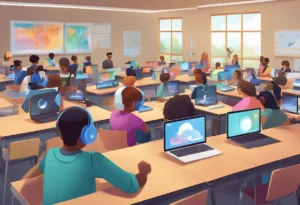
Augmented Reality (AR) is a technology that overlays digital information onto the real world, creating an interactive and immersive experience for students. AR in education is becoming increasingly popular, as it has the potential to enhance learning and make it more engaging. In this section, we will explore the technological tools that can be used for AR in education.
Mobile Devices and AR Apps
Mobile devices such as tablets and smartphones are the most commonly used tools for AR in education. They are affordable, portable, and easy to use. There are many AR apps available for mobile devices that can be used in the classroom. These apps can be used to create interactive lessons, simulations, and virtual field trips. Some popular AR apps for education include Merge Cube, Object Viewer, and Museum Viewer.
Immersive Tools and Resources
Immersive tools and resources are another technological tool for AR in education. These tools provide a more immersive and interactive experience for students. They include tools such as zSpace, which is a computer that students engage with using a stylus and wearing glasses, allowing for a VR experience. Teachers can browse by content-specific lesson plans. Other immersive resources include AR headsets, 3D printers, and interactive whiteboards.
Teacher Training in AR Technology
To effectively use AR technology in education, teachers need to be trained in its use. Many schools and districts are offering professional development opportunities for teachers to learn how to use AR in the classroom. This training can include workshops, online courses, and coaching. Teachers can also learn from other educators who are already using AR in their classrooms.
Technological tools such as mobile devices and AR apps, immersive tools and resources, and teacher training are essential for effective use of AR technology in education. By incorporating AR into classrooms, teachers can create more engaging and interactive lessons that help students learn and retain information better.
AR Applications Across Disciplines
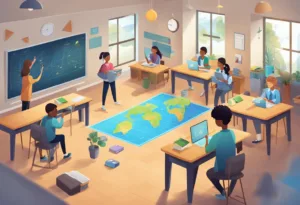
Augmented Reality (AR) has become an increasingly popular technology in schools due to its ability to enhance learning experiences by providing interactive and immersive environments. AR can be used across various disciplines such as math, science, and humanities to provide students with a unique and engaging way to learn.
Mathematics and Geometry Visualization
AR technology can be used to visualize complex mathematical concepts and geometry in a way that is easy to understand. For example, students can use AR to visualize 3D shapes and understand their properties, or they can use AR to solve equations and see the results in real-time. This technology can help students grasp difficult concepts that may have been challenging to understand through traditional teaching methods.
Science and Experiential Learning
AR can also be used in science classes to provide students with experiential learning opportunities. For example, students can use AR to explore the human body and understand its functions or to visualize complex chemical reactions. AR can provide students with a hands-on experience that allows them to understand complex scientific concepts in a more engaging and interactive way.
Humanities and Interactive Media
AR can also be used in the humanities to provide students with interactive media experiences. For example, students can use AR to explore historical sites or to visualize historical events. AR can also be used to bring literature to life by providing students with an interactive reading experience. This technology can help students engage with the material in a more meaningful way and can provide them with a deeper understanding of the subject matter.
AR technology can be used across various disciplines to provide students with an engaging and interactive way to learn. By incorporating AR into the classroom, students can gain a deeper understanding of complex concepts and engage with the material in a more meaningful way.
Enhancing Student Engagement with AR
Augmented Reality (AR) technology has been increasingly used in schools to enhance student learning experiences. AR provides a unique opportunity for students to engage with the learning material in a more interactive and immersive way. In this section, we will explore how AR can enhance student engagement in the classroom.
Motivation and Excitement in Learning
AR can help to increase student motivation and excitement in learning. By using AR, students can visualize abstract concepts in a more concrete way, making it easier for them to understand and retain information. This can lead to increased engagement and motivation to learn. AR can also create a sense of excitement and wonder in students, making learning a more enjoyable experience.
Collaborative and Hands-on Experiences
AR can also enhance collaborative and hands-on learning experiences. By using AR, students can work together in groups to solve problems and complete tasks. AR can also provide students with hands-on experiences that are difficult to replicate in a traditional classroom setting. This can lead to increased engagement and a deeper understanding of the learning material.
Assessment and Feedback through AR
AR can also be used for assessment and feedback. By using AR, teachers can create interactive assessments that provide immediate feedback to students. This can help to identify areas where students may be struggling and provide opportunities for targeted interventions. AR can also provide students with feedback on their progress, helping them to stay engaged and motivated.
AR has the potential to enhance student engagement in the classroom by providing students with more interactive, collaborative, and hands-on learning experiences. By using AR, teachers can increase student motivation and excitement in learning, while also providing opportunities for assessment and feedback.
Research and Efficacy of AR in Education
Augmented Reality (AR) is a technology that overlays digital information onto the real world, enhancing the educational experience. AR in education has been the subject of several research studies and pilot programs. This section explores the efficacy of AR in education, including its long-term educational benefits, challenges, and limitations.
Case Studies and Pilot Programs
Several case studies and pilot programs have demonstrated the effectiveness of AR in education. For example, a study conducted by researchers at the University of Maryland found that AR improved students’ understanding of complex scientific concepts. Another study conducted by the University of California, Los Angeles (UCLA) found that AR increased students’ engagement and motivation in learning.
Long-term Educational Benefits
AR has the potential to provide long-term educational benefits. By providing a more immersive and interactive learning experience, AR can help students retain information better. AR can help students develop critical thinking and problem-solving skills by allowing them to explore and manipulate virtual objects.
Challenges and Limitations
Despite the potential benefits of AR in education, there are also challenges and limitations to its implementation. One challenge is the cost of AR technology, which can be prohibitive for some schools. Not all teachers have the necessary training and expertise to effectively integrate AR into their lesson plans. Moreover, there is a lack of research on the long-term effects of AR on student learning outcomes.
AR has shown promise in enhancing the educational experience. While there are challenges and limitations to its implementation, the potential long-term educational benefits make it a technology worth exploring further.
Future Trends in Augmented Reality for Schools
Advancements in AR/VR Technologies
As technology continues to advance at a rapid pace, augmented reality (AR) and virtual reality (VR) are expected to play a significant role in the future of education. With the development of new AR/VR technologies, students will be able to experience more immersive and interactive learning environments, which will enhance their learning experiences and increase their engagement.
One of the most exciting advancements in AR/VR technologies is the development of wearable devices that can provide students with a more seamless and natural AR/VR experience. These devices will allow students to interact with AR/VR content without the need for a separate device, such as a smartphone or tablet.
Policy and Educational Standards
As AR/VR technologies become more prevalent in schools, it will be important for educational institutions to establish policies and standards for their use. These policies and standards will need to address issues such as student privacy, data security, and ethical considerations.
In addition, educational institutions will need to ensure that AR/VR technologies are being used in a way that aligns with established educational standards. This will require collaboration between educators, policymakers, and technology developers to ensure that AR/VR technologies are being used in a way that benefits students and enhances their learning experiences.
Global Impact on Education Systems
AR/VR technologies have the potential to revolutionize education on a global scale. In many parts of the world, access to quality education is limited, and AR/VR technologies could provide students with access to educational resources that they may not have had otherwise.
However, the implementation of AR/VR technologies in education will require significant investment in infrastructure and training for educators. This investment will need to be made at both the national and international levels to ensure that all students have access to the benefits of AR/VR technologies.
The future of education is bright with the integration of AR/VR technologies. With advancements in technology, establishment of policies and standards, and global investment, AR/VR technologies have the potential to revolutionize education and provide students with more immersive and interactive learning experiences.
Frequently Asked Questions
What are the benefits of using augmented reality in educational settings?
Augmented reality (AR) has the potential to enhance the learning experience by providing students with a more immersive, interactive, and engaging way to explore educational content. It can help students visualize complex concepts, increase motivation, and improve retention rates. AR can also provide opportunities for collaborative learning and enhance creativity and critical thinking skills.
How can teachers integrate augmented reality into their lesson plans?
Teachers can integrate AR into their lesson plans by using AR-enabled devices, such as smartphones or tablets, to display interactive content related to the lesson. They can also use AR apps to create their own content or use pre-existing AR content available online. Teachers can incorporate AR into various subjects, including science, math, social studies, and language arts.
What are the potential drawbacks of implementing augmented reality in the classroom?
One potential drawback of implementing AR in the classroom is the cost of AR-enabled devices and software. Another potential issue is the need for teachers to receive adequate training on how to effectively integrate AR into their lesson plans. Some students may experience motion sickness or other negative side effects when using AR technology.
Can augmented reality tools enhance student engagement and learning outcomes?
Studies have shown that AR tools can enhance student engagement and improve learning outcomes. AR can help students visualize abstract concepts, increase motivation, and improve retention rates. AR can provide opportunities for collaborative learning and enhance creativity and critical thinking skills.
What examples demonstrate the effective application of augmented reality in schools?
Examples of effective application of AR in schools include using AR to teach anatomy, geography, and history. For example, students can use AR to explore the human body and learn about different organs and systems. In geography, AR can be used to explore different parts of the world and learn about different cultures. In history, AR can be used to bring historical events to life and provide students with a more immersive and interactive learning experience.
What does research suggest about the future impact of augmented reality on education?
Research suggests that AR has the potential to significantly impact education in the future. AR can provide students with a more immersive and interactive learning experience, enhance critical thinking and problem-solving skills, and improve retention rates. AR can help bridge the gap between traditional classroom learning and real-world experiences. As technology continues to evolve, the potential for AR in education will only continue to grow.

